Matthew Lanyon interviewed by Michael Bird for The New Craftsman show
September 2012
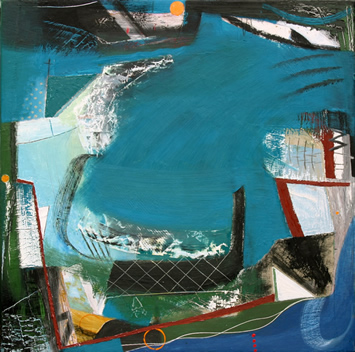
Four Suns 2012
30 x 30 inches - oil on canvas
MB: Did you have particular starting point for the work in this show?
ML: After putting together my New Craftsman show last year, I had one painting left over – this square one with all the blue and the turquoise. I’ve had a real battle with it. It was going to have gold leaf, it was going to be an Annunciation, and so on. And that was the first painting of the year, though it wasn’t finished until very late.
MB: Does it trace a route? Is there a journey or a pathway?
ML: It’s more like what’s left after many routes. There’s a lot of painting over and scraping back. That’s a good rule – if you’re prepared to scrape a painting back, then it’s really begun.
MB: That jar full of dried paint scrapings …
ML: That represents the end of one painting. And that was in pursuit of a particular black. I have been struggling for years with all the blacks, to get transparency, non-shininess.
MB: Why do you want that particular matt black?
ML: I wanted it completely absorbent. The black goes on first. Reds are usually put on later, because they take a lot of oil to bind them.
MB: Yes, that orange there…
ML: ‘Hot Church’ that’s called. That’s a very ‘St Ives’ painting. I was watching a man there laying a double yellow line. It comes in a roll of paint, and he said ‘I’ll give you a bit, I’ve got another roll in the cab’. So that was another starting point, double yellow lines. Underneath the gold in the painting, there were the two yellow lines.
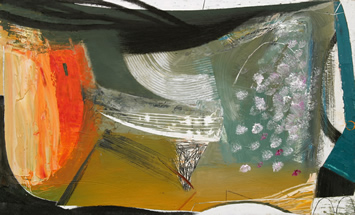
Hot Church 2012
25 x 15.25 inches - oil and gold leaf on board
MB: Did you use the road paint?
ML: I couldn’t figure how to do it. It has to be used on tarmac, and they don’t want tarmac on the floor of the New Craftsman!
MB: I’m interested in how there’s often a feeling of a journey around the four sides of a painting.
ML: I’ll show you [rotates painting]. There’s Land’s End, the Mount … there’s St Just with the cross. Top left there’s a boat coming round the headland, so St Ives is - there. Here’s the Lizard, where my winter sun rises.
MB: A lot of people would look at this and think, ‘Ah, that’s an abstract painting.’ But actually it’s got a very specific topography.
ML: Well, abstract just means something taken away, doesn’t it? It’s like the sculpture question: ‘How do you carve a duck?’
MB: Tell me.
ML: You take away the bits that don’t look like a duck. Abstract is the same thing. You take away a certain amount for your own satisfaction. In my case, I’ve got things that are almost like ciphers or symbols, like a 4 for an airfield or a cross for St Just. They’ve evolved over years. But the advantage of reducing things further and further is that the valency of the sign system increases. These signs are what go around the edges. I have tried to put all the going around in the middle of a painting …
MB: But it always ends up on the edge?
ML: Yes. Most usefully! If you push everything to the edges, then you’ve got a middle to deal with.
MB: When do you decide which way round a painting’s going to be?
ML: It can happen at the beginning or right at the end. I wouldn’t let a painting go until I’ve decided which way round it’s got to be.
MB: Are paintings here that have happened pretty quickly and others that have taken months?
ML: Well, they all take their year.
MB: So you’re working on a lot of paintings simultaneously?
ML: When I started, I thought I should finish one before I started another. It was Rod Walker who said to me, ‘You can start a lot of paintings at once, but you can only finish them one at a time’. That kind of let me off the hook!
MB: You’ve got about 40 paintings here do you see common threads ?
ML: We’ve talked about one thread which is going around – something in the middle and something pushing to the edges. I need the spin of a story sometimes to give myself a bit of headwind - a bit of poetry. All these paintings feel strong on stories to me. They stand alone. Some relate to poems I’ve written or places I’ve been, and the journeys are sometimes ones I travel vicariously. The Costa Concordia wreck in January charged me up. I get swept up when big objects turn on their sides and change their meaning. They become sculpture.
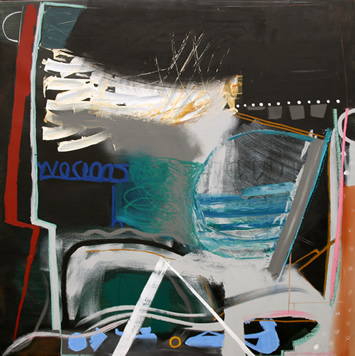
All Hands
60 x 60 inches - acrylic on canvas
MB: Is this an influence in the paintings?
ML: In painting, it’s the same as watching this beast go down alongside St Ives. And there was something else – that captain came from Livorno. I started looking at Modigliani’s hermaphrodites again, because that was his birthplace too. And now there are three paintings this year with hydraulic hermaphrodites being used to raise things up, except the ship has also become a nude. I love these paintings.
MB: Can you tell me about this big painting here?
ML: This is Greenstone. The title in a sense is quite abstract. Obviously there are a lot of greens in it, but it’s had so much going on in it, this painting. It started with a visit to Godrevy, and that was vertical. Then St Ives came in, and it turned horizontal. Finally it’s come up vertical again. I was reading about Alexander Thom, who did a lot of work on the astronomical alignment of standing stones.
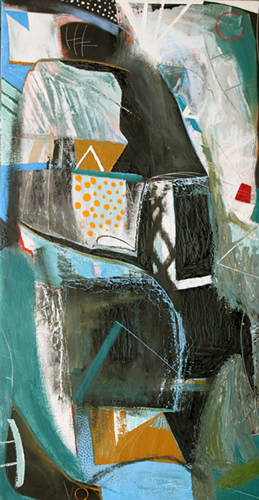
Greenstone
37 x 70.75 inches - oil on canvas
MB: There is something there like a moonrise or sunrise.
ML: Yes, and I was happy with that because it allowed me to stay in the vertical. And then I started digging, with the black, and going down the middle like a shaft. And I thought, I’m on the way to St Just.
MB: Why do you need to know that the little cross is St Just? Why can’t it just be a cross?
ML: Well, when I’ve turned this painting through 360 degrees, I kind of want to know where I was!
MB: And if people don’t know these places?
ML: I think you address your own imperatives. It’s like someone who saw a drawing in the studio and said to me, ‘That looks like somebody in a bath reading a book’. And I thought, I know exactly what you’re seeing – but actually it’s a newspaper!’
MB: Can I ask you about the paintings on glass, because it’s quite an unusual thing to do?
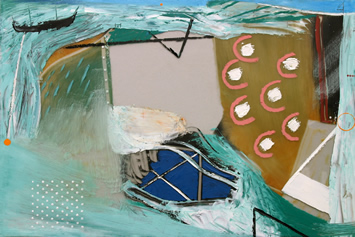
Early Man
24 x 36 inches - oil on glass
ML: I started about three years ago. I put a bit of glass up so I could paint on both sides. It’s more like sculpture. You’re not outside the picture, like in fixed perspective. You’re moving around, like you do when you go for a walk. I’m constantly trying to shift myself towards allowing something to emerge. I consider the image to be an emergent value rather than an imposed value.
© Michael Bird August 2012 |




